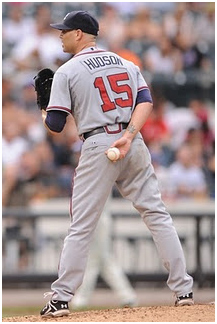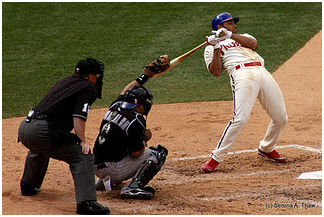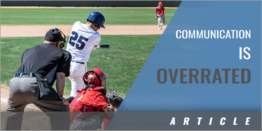|
By: Bob McCreary - Baseball by the Yard
Try to steal your own pitchers' signs When you find out that somehow a team is getting your pitch signs, there are a number of things that can be done. Which solution chosen depends on how they are getting the signs, who is giving them to the batter, and/or what level of baseball this involves. Below are the various things teams can do to prevent their pitch signs from being stolen and passed to the batters. Study your own pitchers and catchers. As stated in Part 1, the most likely way batters get the pitch is by watching the habits of the pitchers and catchers. Because of this, each team should watch their pitchers and catchers carefully to see if they are tipping off their pitches. Some bench guys seem to have a knack for noticing when and how opposing pitchers tipoff their pitches. Have these guys watch your own pitchers and tap into their expertise. They can do the same for their catchers to see if any adjustments need to be made. Some catchers may need to set up for location a little later. This is standard procedure for major league catchers. Most give the sign to the pitcher but wait until the pitcher's delivery starts before moving to the wanted location. They do this to not allow the offensive team time to tell the batter the location of the upcoming pitch. Having bench guys watch for all this gives them something constructive to do during the game as well. Let them know that you know. I will say that the higher you go in baseball, the more likely the pitcher, catcher, or infielder will take matters into their own hands. A major league pitcher probably will take the more direct approach. For example, he may just step off the mound if he suspects something, take a little walk towards second base, and say something to the effect of "keep it up and your teammate is going to get the next pitch right through the ear hole of his helmet!" Although very effective in most cases, obviously a more sportsmanlike approach should be used at the lower levels. That being said, telling someone to stop is, in fact, a good method. Saying "giving signs to the batter can get someone hurt" allows the coach or player to figure out for himself what that means. It also happens to be true. Flashing the wrong sign to a batter can be very dangerous for hitters. For example, if a runner flashes "curve ball" to the batter and the actual pitch is an inside fastball, the batter probably will not get out of the way because he expects it to break away from him if both the pitcher and hitter are right handed or left handed. Players may not care too much if they get hurt themselves but nobody wants to see a teammate get hurt, especially if their misread caused it to happen. Mix up your signs. Obviously, if the team on offense is picking up your signs, an easy way to fix that is to change your signs. If you suspect that your signs are being stolen, call timeout and have the pitcher and catcher adjust their sequence of signs. Frequently changing your sequences if you suspect something usually ends the threat pretty quickly. A future post will be dedicated to showing popular options that are used for pitch calling.
*Promote some distrust. I placed an asterisk next to this one because there are some dangers involved that players and coaches need to be aware of. This technique involves "crossing up" the batter. By that, I mean the catcher puts down the sign for one pitch and the pitcher purposely throws a different pitch. Usually it would work like this. The catcher might put down two fingers to indicate a curve ball. The curve ball sign is then flashed to the batter. The pitcher then throws a hard inside fastball. The purpose of this strategy is to get the batters to no longer trust the signs being flashed to them. You can imagine the surprise of a batter if a slow, breaking pitch on the outer half of the plate is expected and a hard inside fastball is what they actually get. "Crossing up" the hitter like this makes him rethink about his desire to get the signs beforehand. Now the dangerous side. If a batter believes that a slow, breaking ball is coming on the outer part of the plate, he may lean over the plate a bit more on the pitch. He may also not initially attempt to get out of the way of the inside pitch because he may assume the pitch will eventually break away from him. Obviously, it won't. As a result, he may get hit with the pitch. Most of the time if a batter gets hit, he won't get hurt. He learns the lesson and moves on. However, there is always the threat that serious injury could occur especially if the pitch ends up near the head/face area. That location of the pitch coupled with the fact that the hitter will not react like normal can create a big danger. If it should come out later that a pitcher and catcher were told to use this strategy and it resulted in a serious injury, the coach may at the very least have to start looking for another coaching job. Like it or not, stealing signs will always be part of the game. Knowing how it's done, what to look for, and how to stop it are things that all teams should be aware of regardless of whether they personally choose to do it or not. About the Article...
I am proud to come from a baseball family. My grandfather's (Mother's side) name was Hal Kelleher. He pitched for the Philadelphia Phillies in the 1930's. My father was a long time baseball coach at the youth, high school, and college levels. He even had a chance to coach in the College World Series while an assistant at Temple University in 1972. While in the military service, my father was stationed at Fort McPherson outside of Atlanta, Georgia which had a general that was a baseball fanatic. He did everything he could to bring major league players who were drafted into the Army to Fort McPherson. As a result, Fort McPherson was stacked and won the All-Army Championship as a result. My father played second base on that team. Being around those major leaguers was quite a learning experience for my Dad. He learned about the mental toughness of major leaguers and all the finer points that made them tremendous players. Because of all this, from the time I picked up a baseball, I was learning the finer points of the game. Many of the things I was learning at a young age are not generally taught to players until they get into the higher levels. I was very fortunate to have those good baseball people close to me. When I finished my playing career, I decided I wanted to pass on these finer points to as many players, coaches, and parents as I could. My coaching, this website, and especially my blog are all an attempt to do that. I hope you enjoy what I have to offer. If you are a player or coach, I hope that something you learn from me gives you a better chance at playing and/or coaching at the levels I have been fortunate to experience. Best of luck to all of you on your baseball journey! Bob McCreary |








